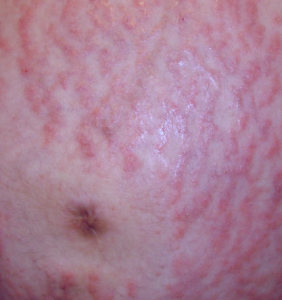It is also one of the most commonly identified skin rashes among pregnant women. The rashes start developing around the 7th or 8th month but it also changes according to the person. It is also known by the name of toxemic rash, PEP (Polymorphic Eruption of Pregnancy), late-onset prurigo of pregnancy, and toxic erythema of pregnancy. The symptoms and associated discomforts are prominent. Itching can continue for weeks and the bumpy rashes can be annoying.
Causes
The cause of this condition is not really established. The medical research has listed numerous factors such as the relationship between PUPPP rash and dairy. Women are suggested to stop consuming dairy products. The rashes occur usually during a woman’s first pregnancy and in the third trimester with a possibility of affecting women with multiple pregnancies more as compared to others. This is one condition that is agreed upon by the majority of experts.
PUPP rashes do not develop due to hormonal changes during pregnancy. A theory suggests that destructive cells penetrate into the mother’s skin and causes an itchy belly. Some also believe that it could be genetic and could be traced from the father’s side. Hypertension is also believed to be one of the potential causes.
Signs and Symptoms of PUPPPs
- Itching is one of the most worrying parts of PUPP’s. Many women feel that it’s the worst
- Red rashes due to itchiness
- Blisters that are small in size
- Lesions similar to the ones in Eczema appearing on the abdomen
- Stretching and stretch marks
- The papules are bumpy, itchy and red welting over a period of time. There aren’t any rashes on the belly button but just around the abdomen.
- Rashes can spread to other areas like arms, chest, legs, thighs and neck.
Treating PUPPP
Since the skin becomes sensitive and the condition is severe, the doctors usually prescribe topical moisturizing creams and aqueous ointments. When the condition is extremely sensitive Corticosteroid creams and ointments are prescribed. Oral corticosteroids, Class I and II corticosteroid are also given in very severe cases. However its application should be carried out keeping in mind the safety of fetus as the corticosteroid is high in potency. In order to provide relief from the itchiness Antihistamine tablets could also be prescribed. However they are not as effective as the corticosteroid creams and ointments. In most of the cases the symptoms and conditions start disappearing after the birth of the baby. However in some rare cases women continue to experience these symptoms even in their postpartum period. Pine tar soap, oil or pine tar body wash can be used to bring some relief as it can keep the skin cold and give a soothing effect. Cold showers and iced cloths can also be used.
Home remedies
A lot of women prefer home remedies to treat PUPPP. Some of the remedies are:
- You can take baths made up of baking soda, Aloe and oatmeal. It will help to bring the itchiness down and will also help in decreasing the redness of rashes and marks. Aloe vera gel after the shower can also be applied at the affected area.
- Ice packs and cold compressors are also helpful when it comes to healing the redness and swelling.
- It is suggested to wear loose baggy clothes in order to avoid such skin problems during pregnancy. One should always wear soft and loose cotton clothes as much as possible. If you cannot help scratching then wearing gloves is must.
- Staying indoors and in cooler places is important. One should try and stay away from the heat, sun, and avoid warm water on the body as it can aggravate the rash, itchiness and other symptoms.
Even after these measures if itching is unbearable, then you must consult your dermatologist about other medications such as anti-itching creams. Unfortunately, there are no preventive measures to avoid PUPPP, the only blessing is that its temporary and doesn’t affect the baby in any way.
Pupps Rash Pictures


